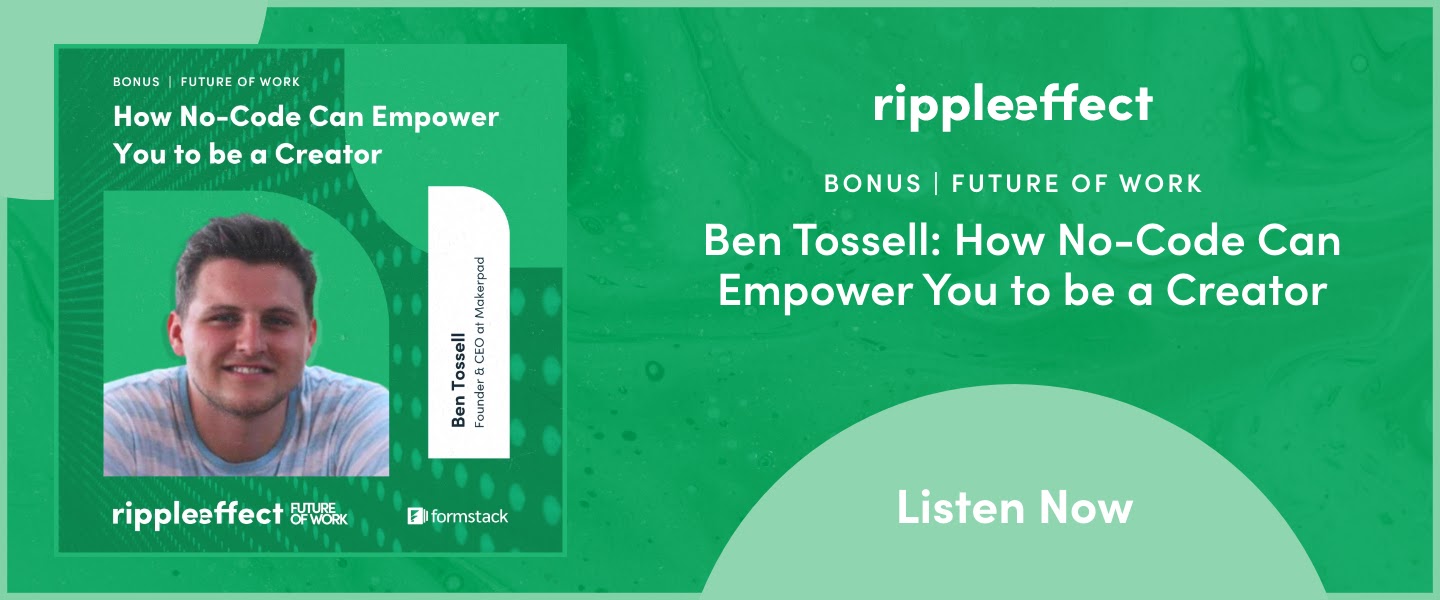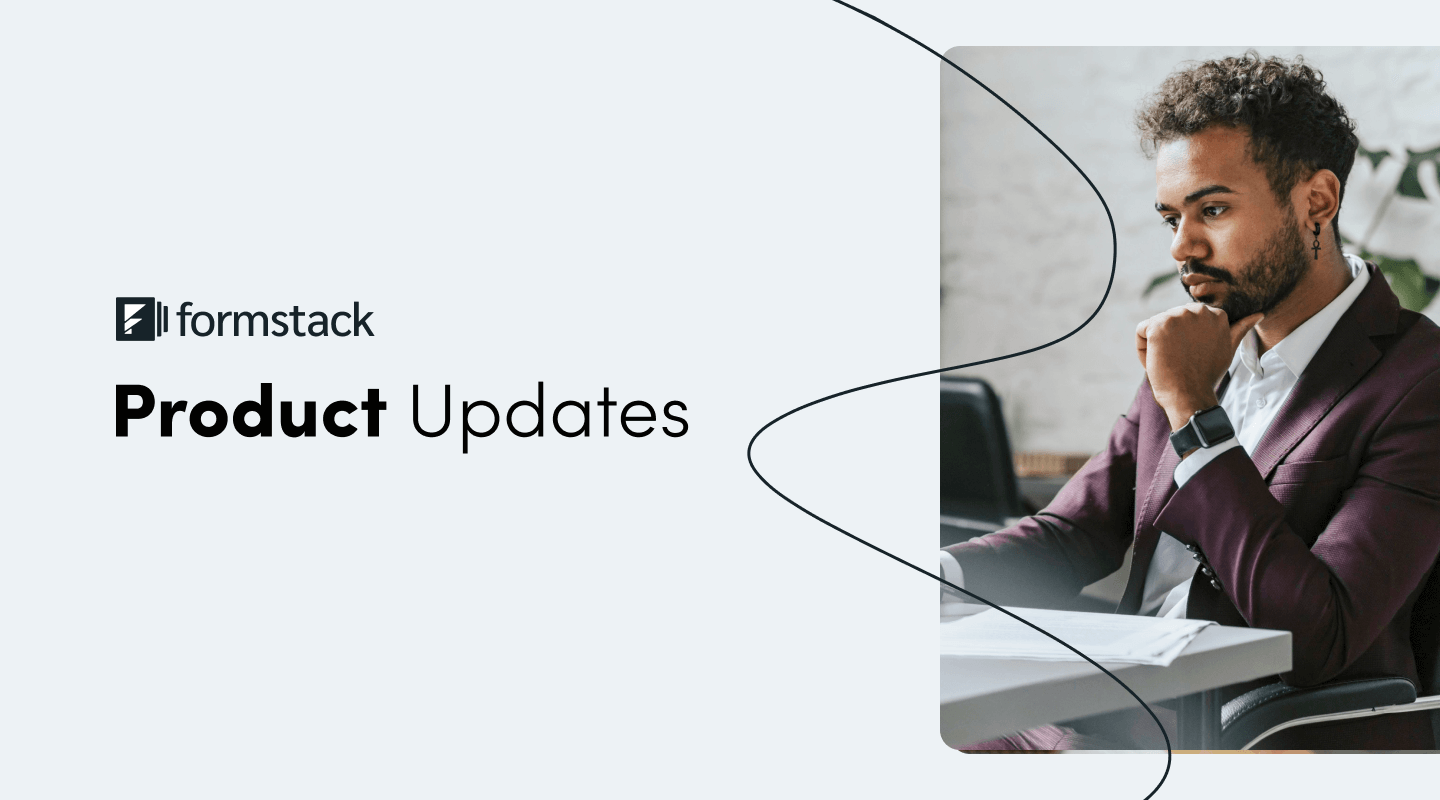No-code tools allow anyone with an idea to quickly and easily bring it to fruition, but there’s a catch: Not very many people are familiar with no-code and low-code tools and what value they bring to the table.
Because we offer various no-code and low-code solutions, we want to tell this story. First, we surveyed 1,000+ employees across various industries, job levels, and company sizes and turned our findings into a comprehensive report titled The Rise of the No-Code Economy. Next, we hosted a live panel featuring no-code and low-code experts from Formstack, Bubble, Webflow, and Adalo to discuss our survey findings and provide additional insights from their firsthand experiences in the no-code space.
We released the report and hosted the live panel on April 13, 2021, Formstack’s first official No-Code Day. More than 1,000 people signed up for our panel and took part of the No-Code Day celebration!
Here are the key highlights you can take away from the full panel discussion.
Our 2021 No-Code Economy Survey revealed that 82% of people are unfamiliar with the term no-code. Why is that?
Formstack CEO Chris Byers opened up the discussion noting that people are seemingly unaware of no-code software and tools because their focus is more on use cases and finding solutions to those specific problems. What they’re not aware of is that these tools exist and are also rapidly growing in accessibility to solve those problems, but more education is needed to bridge the gap between use case problems and using no-code tools to solve them.
Co-founder and CEO of Webflow Vlad Magdalin echoed Chris’s sentiment that education is key. He noted that tools like Microsoft Excel, which has been used to solve problems for many years now, could easily be considered no-code but it has never been positioned that way leading to more people unfamiliar with the term.

Our 2021 No-Code Economy Survey also revealed that 66% of people started using no-code tools within the last year. What led to the dramatic rise in adopting no-code over the last 12-24 months?
Co-CEO of Bubble, Emmanuel Straschnov, took a stab at answering this question in two parts. First, he noted that when learning to code became popular in 2015 and 2016, people were unaware of how difficult that was going to be. While they were learning the basics of coding, turning those lessons into usable apps and software was a much larger feat and thus turned many people away. Second, no-code and low-code tools have significantly improved over the past few years, which has made their adoption much more popular.
This question sparked an interesting debate between panel moderator and Head of Education at Adalo, Lacey Kesler, and Emmanuel Straschnov. Lacey piggy-backed off Emmanuel’s initial comments with the idea that no-code and low-code apps are starting to take off because the younger generations have been raised with technology and are able to digest technological advancements at a faster pace. While Emannuel didn’t fully disagree, he noted that Bubble has many customers in their 50s and 60s who came to understand the idea of no-code through the rise of Microsoft Access in the 1990s.
What we noticed is we have certain users who were looking for Microsoft Access for the web and that’s a little of how I could describe Bubble in some ways. Certainly, each new generation that joins the workforce is mostly native but I wouldn’t discard older times of technology. - Emmanuel Straschnov
Vlad agreed with Emmanuel’s sentiment that no-code is not taking off because these tools are new, but rather, because there is more available proof that they work!
Why should businesses invest in no-code tools?
Chris Byers immediately jumped in to say that he believes most people in the workforce are smart, driven, and capable enough to see the problems they need to solve and how to get there. The problem is then facing the challenge of executing those mapped out solutions by calling IT or learning a robust software, which ultimately slows down the problem-solving process. With no-code tools, workers can break down some of those barriers and solve problems quicker.
As we know, if we don’t solve a problem pretty quickly we lose energy, we kind of lose the passion to get it done, and that by itself kills too many projects. - Chris Byers
Emmanuel went a little further to note that not only do no-code tools help solve problems faster, when you’re building the solution first hand, you also know the problem at a deeper level which ultimately lends itself to more successful solutions.
Vlad noted that no-code, while not always the right tool for the job, often provides the more efficient and low-cost solutions that businesses are looking for.
56% of people who know how to write code use no-code tools. Why has there been such a great adoption of no-code among developers?
Ironically, Formstack was born out of this exact concept where founder, Ade Olonoh, a longtime developer, was tired of wasting time on a project—in this case building forms—that could be more automated.
Emmanuel echoed this idea by noting that developers are welcome to tools that can lighten their workload.
The biggest impact of no-code may actually be that finally we free the time of engineers to do value-adding things. - Emmanuel Straschnov
Vlad noted that he is a developer and still created Webflow with the same idea in mind, stating, “Why not make things more convenient and easier for myself?” He continued with, “Developers are always looking for efficiency, so that statistic isn’t surprising at all.”
What challenges or hurdles stand in the way of a wider adoption of no-code tools?
Vlad took the opportunity to redirect this question back at panel moderator Lacey Kesler seeing as her role as the Head of Education at Adalo lends itself to an interesting perspective. Her take? Education is key.
Chris added that educating from the top down will help facilitate a quicker adoption, encouraging executive teams to take initiative in providing that education and training from the start.
Vlad went further to say that awareness and literacy of software concepts and the types of problems software can solve is 90% of the battle. If businesses provide an elementary level education and awareness of these tools, wider adoption will inevitably occur.
Emmanuel, while in agreement that education is the enabler, added that social validation or success stories will ultimately drive toward wider adoption. He states, “we’re still in a space where the skepticism, particularly from the technical community, is not negligible.”
What will happen to developer jobs as no-code and low-code solutions become more commonplace?
This was a great question for our panelists to weigh in on as fears of no-code and low-code taking over engineering departments grows.
However, the overwhelming response was that no-code and low-code solutions allow developers to focus their time on the projects that take more attention, and that the need for people that can write code will never go down because there will always be new things that code can optimize.
Let’s be clear, no-code is not going to make people not have jobs. Similarly to older SaaS tools that provide a lot of software as a service would make you assume that you don’t need engineers anymore, but the demand for engineers has never been as high as it is today. - Emmanuel Straschnov
Both the results of our No-Code Economy Survey and the expert perspectives from the panel discussion tell us two things: 1. No-code simplifies business processes, solving more problems while utilizing less time and money, and 2. No-code tools are not a fad or trend; they’re here to stay.
Download The Rise of the No-Code Economy Report for more survey findings and expert insights on how you can take advantage of this emerging economy.











